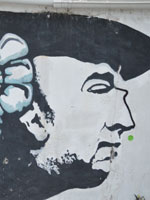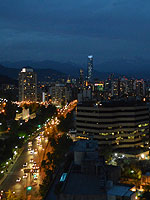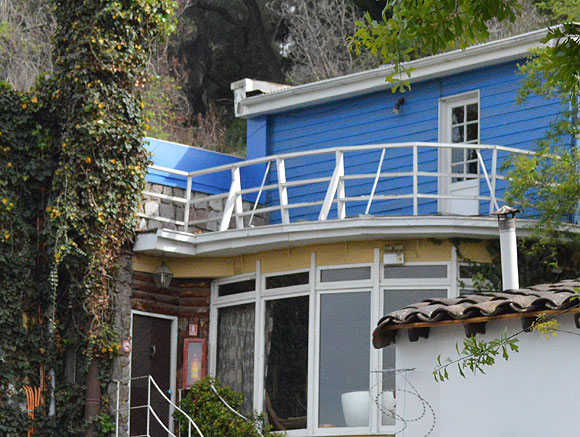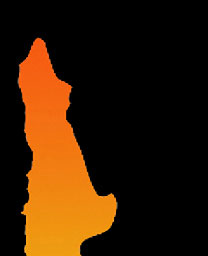

|
Día de la Raza in SantiagoOctober 12, 2014 I started the day by wandering down to the park across from my building. A small footbridge, arched in a Japanese style, carried me across the muddy brown Mapocho River. It was a curious footbridge, the railings of which were adorned with hundreds of padlocks. Many of them were painted with the names of presumed lovers, a tender symbol of attachment on a bridge over muddy water. Over the next couple of weeks, this was a sight I would see again and again on bridges throughout Chile.  La Chascona looks unimposing, hidden under the shadow of Cerro San Cristobál Across the river, I made my way into Bellavista, a bohemian barrio of narrow streets in the shadow of Cerro San Cristobál. At the end of one of these streets is La Chascona, which was for many years the Santiago home of Pablo Neruda. La Chascona was the nickname of Matilde Urrutia, Neruda's third wife, and is a reference to her wild and disheveled hair. She continued to live in this house even after Neruda's death in 1973, until her death in 1985. The house is charming and filled with mementoes of the poet's life, his travels around the world, and his vast collection of art. I spent much of the morning walking through La Chascona, enjoying the gardens and the sweet calm of Bellavista. Then I walked back through Plaza Caupolicán, at the foot of the funicular that goes up to Cerro San Cristobál. A small children's market was in the plaza, with all manner of plastic gaudy colorful toys. I meandered down Calle Pio Nono, the main commercial street of the neighborhood, and back across the Mapocho River. The vast expanse of Plaza Italia was starting to fill up with the early preparations for the grand procession down the Alameda to commemorate Día de la Raza. It was on this day 522 years ago that Christopher Columbus set foot on the shores of what came to be known as the New World. The Mapuche, Aymara, Quechua, and other indigenous people of Chile were gathering to demonstrate that they are still here after all these years of subjugation. I began to notice that Santiago had developed a new coat of graffiti overnight, portending the radical day ahead. My plan was to listen to the speeches in Plaza Italia and then watch the procession as it filed out down the Alameda. But the adrenaline began to build and lead me along with the marchers, feeling the intoxication of the music, the chanting, the rebellion. The overall atmosphere was peaceful and joyful, with marchers dressed in colorful attire, performing traditional songs and dances. A diverse procession marches down the Alameda through the heart of Santiago A more angry and radical element was also present in the crowd, and this became more apparent as we moved down the Alameda to La Moneda, the presidential palace. A group of young men carrying long sticks ran out across the street and began to smash the glass panes of the bus shelters. Small debris was thrown into the street and set on fire. A few Chilean flags were burned as well. The police began to react and move in around this time. Adrenaline has an amazing ability to counteract the effects of tear gas. My throat was raw and eyes watered from the searing pain, but I couldn't help but move toward the clouds of acrid smoke. We were getting closer to La Moneda and a block ahead of me I could see crowds of people break into a frantic run. Tanks and trucks equipped with water cannons wheeled out into the street in front of the crowd. A spray of tear gas came from one of the tanks, shooting out across the crowd. People covered their faces with bandannas or their shirts, while a few people came prepared with gas masks. Aymara dancers transform the Alameda into a stage for their performance The pulsating crowd was unpredictable and chaotic. People began to knock down the metal barricades that lined the street in front of La Moneda. They dragged them to the nearby intersection and formed a large pile with them, directly across from a forboding wall of police in full riot gear. As the police amassed across the street, lined up on foot or sitting inside the ominous presence of the tanks, the marchers banged on the barricades, taunting the police with an unrelenting percussive rhythm. I moved further down the Alameda, sensing a tension in the air and trying to stay alert to my surroundings. From behind I heard shouting and looked to see the crowd breaking into a run again, heading straight for me. Behind them were the tear gas cannons, approaching rapidly and spraying indiscriminately in all directions. I felt a sense of panic come over me as I looked straight ahead and saw more police and tear gas cannons coming from the other direction. Then out of nowhere, an armored police car whipped around a corner and was right in front of me. I saw some sort of canister come flying out from the vehicle, landing a few feet away from me. I took shelter behind a small concrete wall, where others were pressed tight against the ground. Three elderly Aymara women, in full traditional regalia, were crouched up against the wall, along with some young men who were protecting them. I didn't know these people but we all huddled together closely like old friends. Choking and gasping from the tear gas, I heard one of the men say "tenemos que ir" (we have to go). The Aymara women rose and I followed them closely; together we made it to a grassy lawn where the tear gas was not so strong. I looked around and saw that we were at Plaza Los Heroes, the designated end point of the march. The police were gradually clearing the barricades and opening the street back up to traffic. I gathered my strength and began to walk slowly back along the Alameda. I could hear the subway trains passing by underneath me, but when I got to La Moneda station, the doors at the entrance were closed and locked. I reconciled myself to walking all the way back to Providencia. Santiago was slowly returning to normal after a day of defiance and rebellion in the streets. |
||||||||||
|
|||||||||||
 |
|||||||||||
|
© 2015 Michael Hanrahan
|
|||||||||||


